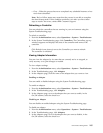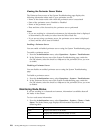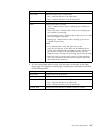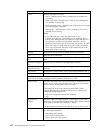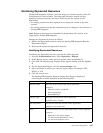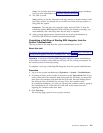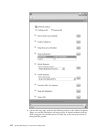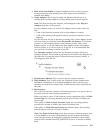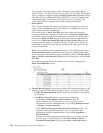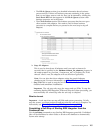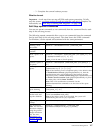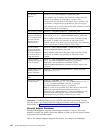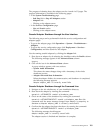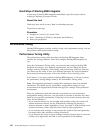
a. Mark Node Unavailable In cluster installations, this is used to prevent
business processes from coming from other nodes to the node that is
marked unavailable.
b. Notify Adapters This is used to notify all adapters that the server is
shutting down so that adapters will stop taking new external requests.
Note: This does not stop the adapters, which happens at the Stop All
Adapters step later in this process.
For the container node, you will see the adapter session status with two
lists:
v A list of the business processes with a client adapter in session.
v A list of the running and queued business processes invoked by server
adapters.
For the ASI node, the list of business processes with a client adapter session
will show after you click the button Execute BPs On Queues. If a business
process is a sub business process of the business process with a client
adapter session, it will not inherit the client adapter session information
from its parent, so it will not show up in the list. It is recommended that
you use in-line invoking to invoke a sync BP.
The Transport Sessions section lists the business processes with active
transport sessions. Those business processes are invoked by the adapters on
the node that is being shut down. When the business process finishes, it
will disappear from the list.
c. Stop Resource Monitor This is used to stop the resource monitor.
d. Stop Scheduler This is used to stop the scheduler in both clustered and
standalone installations. In a clustered installation, this is used to move
schedules to another live cluster node. A table lists the active schedules for
the node.
e. Block Queues
This is used to stop the execution of business processes on a queue and not
let nodes send any new business processes to it.
When you block a queue, if the business process completion policy is Finish
Current Step, the executing business process will exit after it finishes the
current step.
If the policy is Finish Current Execution Cycle, the executing business
process will exit after it finishes the current execution cycle.
If the policy is Finish Business Process (the default value), the executing
business process will not exit until it finishes.
Note: The Finish Current Step option does not stop a business process that
is in the middle of an open communication session. Instead, the softstop
waits until the session is terminated. Following termination, the business
process will be marked HALTED_SOFTSTOP or move to another available
node.
Performance Management 113



